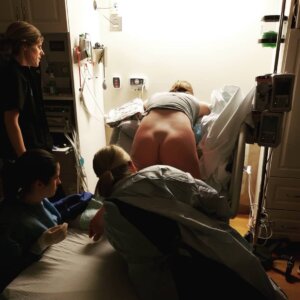Induction For A Big Baby
Induction For A Big Baby… if it’s not recommended by guidelines then why are so many women being offered inductions??
So, a bit of background… NICE guidelines state that women shouldn’t be advised to have an induction of labour for a predicted big baby, where there are no other factors to consider (such as diabetes).
Let me bust some myths for you about birthing a predicted big baby…
⠀⠀⠀⠀⠀⠀⠀⠀⠀⠀⠀⠀⠀
- Your baby’s bones in its head aren’t fused. Baby’s heads are more like plates of the earth rather than one large bone. They are soft and can move to fit through your pelvis, called “moulding.” They can even overlap so that their heads are a smaller diameter.⠀(Photo A)
- Your pelvis when pregnant can expand in diameter by up to 28%. Relaxin is a hormone that increases as you get towards your due date and is a right pain in the peach for when you’re pregnant but, it’s very useful for birth. It’s like the WD40 for your joints and makes your screws loosen in your pelvis so they can accommodate your baby travelling through. See photo B of this happening during birth. This is showing the pelvis moving and this sign is called the Rhombus of Michaelis (sounds super geeky right?)
- Scans are notoriously inaccurate for measuring size. They are beneficial for trends in growth rather than a one-off measurement. ⠀⠀⠀⠀⠀⠀
- Photo A – Baby’s skull bones aren’t fused to allow for overlap.
- Photo B – A mothers pelvis moving to accommodate baby
The next time a relative says “How you gonna push out that massive baby??”, you can reply, “? Have you not heard of the Rhombus of Michaelis” followed by your best smug face ? ( or you can just think about these above points.) Either way, you’ll feel much better.⠀

So why do so many women with predicted big baby’s get offered inductions….?
There was a Cochrane Review that was published, (a Cochrane Review being a tip top piece of evidence as it looks at several pieces of evidence to find results) that found that for women, who didn’t have diabetes, who were predicted a baby over 4kg (about 8lb 13oz) were less likely to have shoulder dystocias if they had an induction compared to women who waited for labour to start spontaneously. (By approx 27 per 1000 births)
Percentage of women to have a shoulder dystocia when there baby was predicted over 4kg….
4.1% in the Induction Group
6.8% in the Waiting for labour to start Group
On average, baby’s weighed 178g less in the induction group, which could be the contributing factor to this reduction in shoulder dystocia.
You can see that in both groups, it is a relatively rare thing to occur. The large majority of babies measuring big are birthed with no complications.
Implications of a shoulder dystocia
The reason why we want to reduce shoulder dystocias are because they can cause injury to baby in the form of injury to the nerves and also lack of oxygen. Both of these complications can lead to life long disability. Shoulder dystocia’s can also cause fractures- an awful thing to happen to a baby during birth, but fractures heal. A fractured collarbone on a baby won’t hold the same long-term, physical impact to a baby than the above nerve damage and lack of oxygen.
What was interesting about this Cochrane Review was although there were less shoulder dystocias in the group that were induced. There wasn’t a clear difference in the group between nerve damage or baby’s Apgar score or blood gases.
Meaning that induction of labour didn’t appear to have any positive impact when looking at nerve damage and baby’s health at birth, or long term health of baby.
Induction of labour did though reduce fractures caused by shoulder dystocias by approx 16 per 1000 babies.
Percentage of fractures…
0.4% in the Induction Group
2% in the Waiting Group
So what did the research say about the effects of induction of labour vs. Spontaneous labour for women.
There was no clear difference between the two groups of the amount of cesarean births or instrumental births. Both groups had a similar amount of both cesarean births and instrumental births.
Perineal tears were suggested to be more likely in the induction group.
The research didn’t look at Mums experiences or compare effects on mental health.
So, even though the guidelines don’t suggest to advise induction of labour for a big baby. A Dr, is bound by her duty to tell you about risks if you fall into a category (Montgomery Ruling) and then give you an option to have an induction if you’d like.
To see all the statistics from this research have a look here…
Remember, this information here is to help you have more informed conversations with your obstetrician about the choices you’d like to make in your birth. It’s not to replace medical advice.
MANY of your fears about birth can be squashed with some myth busting and change of your mindset/perception. Or you can grab the reigns and feel more in control and informed with stats like above. I can help you do both these things with The Bump to Baby Chapters Online Antenatal and Hypnobirthing Course.
This course will CHANGE THE WAY YOU BIRTH for the better.
Featured photo of baby @patriesblogger & @jessica_vi_photography


